#source: the musketeers (2014)
Explore tagged Tumblr posts
Text
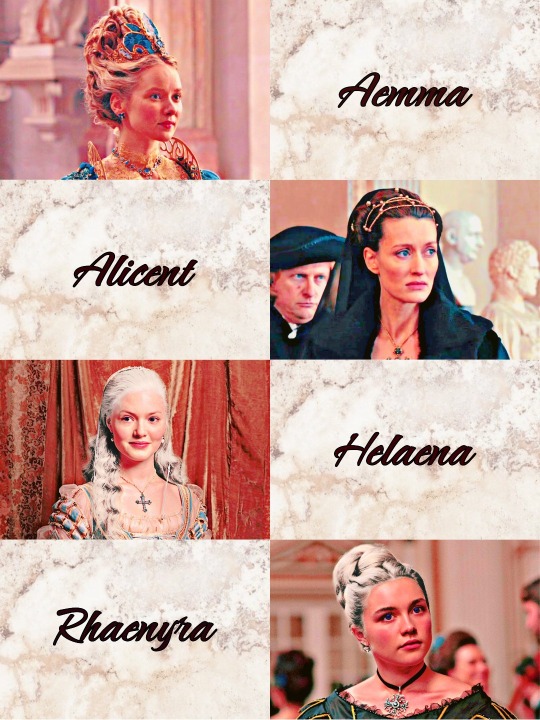
Queens of the Seven Kingdoms -> Mothers and daughters
#aemma arryn#fc: alexandra dowling#alicent hightower#fc: natascha mcelhone#helaena targaryen#fc: holliday grainger#rhaenyra targaryen#fc: florence pugh#source: the musketeers (2014)#source: romeo and juliet (2013)#source: the borgias (2011)#source: little women (2019)#asoiaf edits#made by me
24 notes
·
View notes
Text
The Musketeers (2014-6)
Soldiers of the king fight wars, play politics, and defence the citizens of France while trying to balance the trials of life.
All of the cast suited their roles well and the main four were different enough that the kinds of back stories had some variety. Each season felt consistent but fairly different since the main villain changes with each one. The first season antagonist was the strongest, then the third although the story was divided up among several minor ones for that season, and the second one was a little too obviously untrustworthy.
Even though there was plenty of action and the sword fighting was very competent, seeing an actual swordfight isn’t especially dramatic. It’s more engaging when fire or gunpowder is used, although it makes things a little less realistic for the period. It was a shame we didn’t get to see the Cardinal’s end but the actor had to move on to other commitments.
The era felt consistent thanks to the sets and costumes which had some variety and many were rather stylish. There are some pretty good lines, mainly when the characters are outright insulting one another. The political aspects of the stories clearly had some thought go into them and there didn’t seem to be too much historical innacuracy or deviation from the source material.
Although there are only 30 episodes, the structure only has so much range considering the limited resources and plotical confinements the characters have to deal with. This makes the stories more character driven at least but most of them have plot armour since the main musketeers can’t die without ruining the experience and many of the minor characters are too nice to lose.
6/10 -Just a cut above average-
3 notes
·
View notes
Text
Magnificent Musketeer Tournament
Aramis Poll 2 - Round 2
In this poll, the 2 Aramis entrants with the most votes will move on to the next round



Aramis - Santiago Cabrera The Musketeers 2014-2016
THIS character played by THIS actor is pure, molten fire alchemy. Not just “the pretty one” of the Musketeers (although, dear God, he is certainly that!), IMO he has the most aspects and layers of the quartet. He’s: The Ladies’ Man (natch) The Religious One (who’s willing to damn his immortal soul to save the woman he loves) The Sharpshooter The De Facto Surgeon/Medic (who’s very proud of his needlework) The Insouciant, Quippy One The One Who’s Good With Kids (heartbreakingly, as it turns out) (continued under the cut)
Aramis - Miya Rurika All for One - D'Artagnan and the Sun King 2017
He is just here to be sexy and make that everyone's problem. (Including the audience. We were all fighting for our lives.
Aramis - Romain Duris Les Trois Mousquetaires: D'Artagnan 2023, Les Trois Mousquetaires: Milady 2023
1. HE IS SO GORGEOUS 2. he has The Aramis Facial Hair 3. he is an ally to bisexuals (porthos) 4. in the movie, he takes a carving of jesus on the cross off of a wall and sharpens the end of it into a stake, which he then uses to torture information out of a man. and i think that's beautiful.
The complete list of entrants can be found here.
More information & links to the other polls here.
Additional Propaganda under the cut
Santiago Cabrera:
(continued from above) The character certainly gets run through an emotional wringer over the course of the series, easily sliding between his many facets: cheeky flirt, haunted soldier, mischievous trickster, brave stalwart, murderous alpha male (especially if anyone threatens the Queen), yearning smitten kitten, guilt-racked penitent, longing secret father, kind friend to the downtrodden, justice seeker, etc. From very early in the series, we see that underneath that pretty, pretty facade and devil-may-care attitude lies a man with some deep hurt, sadness, guilt, and self-recrimination. And that only gets more pronounced throughout the series. And then, of course, there’s his glorious mane of unruly dark hair and deep brown eyes. That’s just freaking catnip for me. I love him. He is unforgettable and has lived rent-free in my head ever since.
https://www.tumblr.com/greengableslover/757444812455706624/period-drama-appreciation-week-2024-day-2?source=share
He absolutely nails the dichotomy of the character, both soulful and badass. He’s just so dammed good. And so very, very pretty.





Miya Rurika:


youtube
Romain Duris:



#musketeers poll#aramis poll#aramis#santiago cabrera#the musketeers#bbc musketeers#miya rurika#all for one d'artagnan and the sun king 2017#romain duris#les trois mousquetaires: d'artagnan#les trois mousquetaires: milady#les trois mousquetaires 2023#the three musketeers: d'artaganan#the three musketeers: milady#the three musketeers#Youtube
61 notes
·
View notes
Text
Aaron Tveit appreciation post.
Movie appearances/roles:
2008-Ghost Town (Anesthesiologist)
2010-Howl (Peter Orlovsky)
2011-Girl Walks into a Bar (Henry)
2012-Premium Rush (Kyle)
2012-Les Misérables (Enjolras)
2013-A Dream of Flying (The Young Man) Short film
2015- Big Sky (Pru)
2016-Undrafted (John "Maz" Mazzello)
2016-Better Off Single (Charlie) Previously named Stereotypically You
2017-Created Equal (Tommy Reilly)
2018-Out of Blue (Tony Silvero)
TV roles/appearances:
2009–2012 Gossip Girl (William "Tripp" van der Bilt III) 10 episodes
2010 Ugly Betty (Zachary Boule) Episode: "All the World's a Stage"
2010 Law & Order: Special Victims Unit(Jan Eyck) Episode: "Beef"
2011 Body of Proof (Skip) Episode: "Point of Origin"
2011 Law & Order: Special Victims Unit (Stevie Harris) Episode: "Personal Fouls"
2011 The Good Wife (Spencer Zschau) Episode: "Executive Order 13224"
2013–2015 Graceland (Mike Warren) Main cast; 38 episodes
2016 Grease Live (Danny Zuko) Television movie
2016 BrainDead (Gareth Ritter) Main cast; 13 episodes
2017–21 The Good Fight (Spencer Zschau) 3 episodes
2019 The Code (Matt Dobbins) 5 episodes
2020 One Royal Holiday (Prince James Gallant) Television movie
2021 American Horror Stories (Adam) Episode: "Rubber(wo) Man Part Two", (Jay Gantz) Episode: "Feral"
2021–present Schmigadoon! (Danny Bailey) Main cast; 6 episodes
Theatre works:
2003 Footloose (Garvin) Merry-Go-Round Playhouse [2003 Regional production]
2004 Rent (Steve, u/s Roger, Mark) US national tour [January – December 2004 National tour replacement]
2005–08 Hairspray (Link Larkin) US national tour [August 2005 – July 2006 First national tour replacement], Neil Simon Theatre [July 18, 2006 – January 18, 2007; April 1 – May 4, 2008 Broadway replacement]
2007 Calvin Berger (Matt) Barrington Stage Company: [July 3–14, 2007 Original regional production]
2007 The Three Musketeers (D'Artagnan) North Shore Music Theatre [August 21 – September 9, 2007 Regional production]
2008–10 Next to Normal (Gabe Goodman) Second Stage Theatre [January 16 – March 16,2008 Original Off-Broadway production], Arena Stage [November 21, 2008 – January 18, 2009 Original Washington, D.C. production], Booth Theatre [March 27, 2009 – January 3, 2010 Original Broadway production]
2008 Saved! (Dean) Playwrights Horizons
[May 10 – June 22, 2008 Original Off-Broadway production]
2008–09 Wicked (Fiyero Tigelaar) Gershwin Theatre [June 24 – November 9, 2008;
January 20 – March 9, 2009Broadway replacement]
2009–11 Catch Me If You Can (Frank Abagnale, Jr.) 5th Avenue Theatre [July 28 – August 16, 2009 Original Seattle production] Neil Simon Theatre: [March 11 – September 4, 2011 Original Broadway production]
2010 Rent (Roger Davis) Hollywood Bowl: [August 6–8, 2010 Limited engagement]
2014–15 Assassins (John Wilkes Booth) Menier Chocolate Factory: [November 21, 2014 – February 8, 2015 Off-West End revival]
2017Company (Robert) Barrington Stage Company: [August 10 – September 10, 2017 Regional revival]
2018–22; 2023 Moulin Rouge!(Christian) Emerson Colonial Theatre: [July 10 – August 19, 2018 Original Boston production] Al Hirschfeld Theatre: [June 28, 2019 – March 11, 2020, September 24, 2021 – May 8, 2022, January 17 – April 9, 2023 Original Broadway production; paused due to COVID-19 , Won 2020 Tony Award for Best Actor in a Musical, Returning for limited engagement in 2023]
Feb. 9-May 12, 2023 Sweeney Todd (title role) Broadway revival, Lunt-Fontanne Theater (replacement)
Source: Wikipedia









#aaron tveit#musical#les miserables#broadway#graceland#brain dead#next to normal#catch me if you can#hairspray#wicked#moulin rouge#rent#grease#gossip girl
120 notes
·
View notes
Text

Howard Charles as Porthos in ‘The Musketeers’ (TV Series, 2014-2016).
( Source: FARFARAWAYSITE )
#howard charles#the musketeers#porthos#perioddramaedit#fashion#brown hair#brown eyes#17th century#phoebe de gaye
214 notes
·
View notes
Text
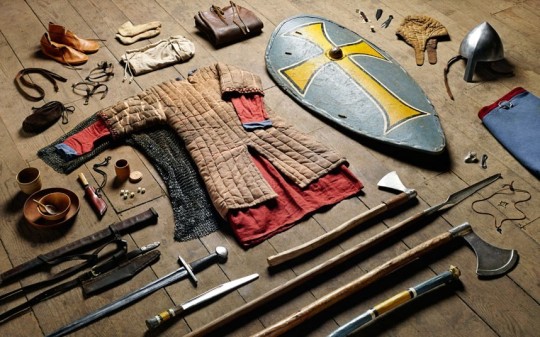



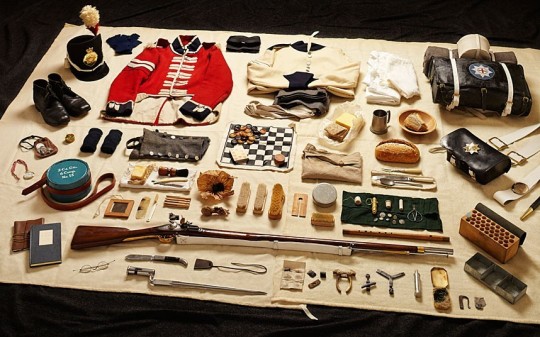
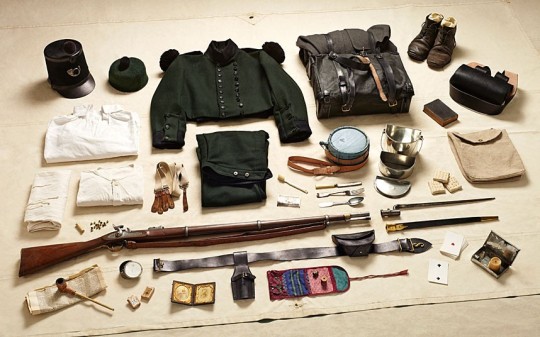
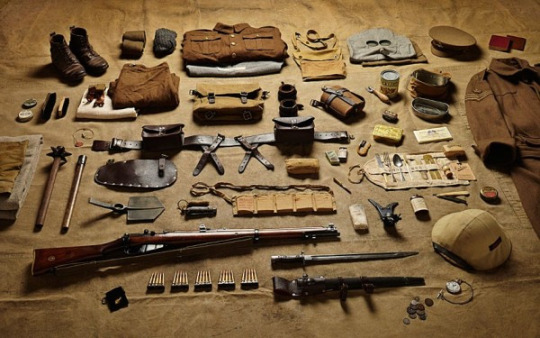


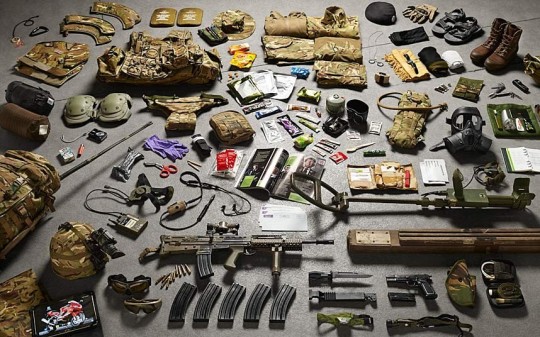
Evolution of the British Military kit. 1066 huscarl, Battle of Hastings 1485 Yorkist man-at-arms, Battle of Bosworth 1645 New Model Army musketeer, Battle of Naseby 1709 private sentinel, Battle of Malplaquet 1815 private soldier, Battle of Waterloo 1854 private soldier, Rifle Brigade, Battle of Alma1916 private soldier, Battle of the Somme 1944 lance corporal, Parachute Brigade, Battle of Arnhem 1982 Royal Marine Commando, Falklands conflict 2014 close-support sapper, Royal Engineers, Helmland Province photographer Thom Atkninson Source
36 notes
·
View notes
Photo

BAROQUE ICONS PACK
By clicking the source link, you’ll find 250 icons for roleplay, made by myself from various baroque sources.
jamestown (2017-2019), nell gwynn (2016), new worlds (2014), salem (2014-2017), the musketeers (2014-2016), the new world (2005), the three musketeers (211), young blades (2001)
Please check the rules!
#icons pack#rp icons#period fc#baroque era#rpg resource#icons#roleplay#forum rpg#baroque#*icons#*mine
9 notes
·
View notes
Text
Time Will Tell
“What happened?”
Scowling to hide his concern, Captain Treville scrutinized the four men presently more or less standing at attention in his office.
They were all covered in a layer of chalky dust. Something wasn’t right with d’Artagnan’s sword arm; he was holding it cradled against his chest, looking pallid. Aramis was leaning against Porthos and not putting weight on his right leg, while Porthos himself had the hunched posture of a man with injured ribs. The only one standing ramrod-straight was Athos, in spite of blood trickling down his face from a wound hidden underneath his hat.
“That warehouse you sent us to investigate?” Porthos grumbled and paused to spit dirt from his mouth.
“What about it?”
“Not standin’ anymore.”
“What?!”
“It was a trap,” Athos revealed in his cool, composed voice. “Kegs full of gunpowder. Fuses were lit when we entered. Couldn’t put them out.”
His lieutenant was acting unfazed, but from his inelegant shorthand Treville could tell that the former nobleman was either shaken or in pain and hiding it bravely.
He stared at the four men in disbelief.
“Are you telling me that the building exploded? With you still inside?”
“Yes,” d’Artagnan answered awkwardly when Athos didn’t reply. The Gascon winced at every small movement, and Treville had the dawning suspicion that his arm was indeed broken.
“Good god,” the captain gasped. “Then how did you-”
“Porthos,” Aramis cut in, shifting on his good leg. “Porthos saved us. Us and the children.”
And that was as much of an answer as Treville would get, for, all of a sudden, Athos began to sway in place, and his eyes lost focus.
“Athos!”
D’Artagnan grabbed him but couldn’t steady him with his one functioning hand. Luckily, Treville’s reflexes were still fast, and he darted from behind his desk to sling his arms around his fainting lieutenant. He lowered him into a nearby chair where Athos sat, blinking dazedly, but somehow staying conscious.
“That’s enough,” Treville stated. “To the infirmary, all of you! The rest of your report can wait. Athos, can you walk?”
Athos nodded sluggishly, hat askew, blood now dripping from his face into his lap. He attempted to push himself up on shaky legs and had to sit back down.
“Never mind, son,” Treville said gently. “I’ll give you a hand.”
During their trek downstairs, Athos’ arm draped across his shoulders, Treville couldn’t stop himself from enquiring further.
“Children?”
“Yes,” Aramis confirmed, grunting as he navigated the steps with Porthos’ aid. “Orphans. They’d taken shelter there for the night. We went back in after the explosion to get them out. Before the warehouse collapsed entirely.”
They had reached the bottom of the stairs and shuffled over to the infirmary under the puzzled gazes of a stable boy and two fellow-Musketeers in the courtyard.
“Were they harmed?” Treville asked.
“Nah, jus’ scrapes an’ bruises.” Porthos waved with the hand that wasn’t supporting Aramis. “An’ the dog’s fine too.”
“Dog?” Treville raised his eyebrows.
“They had a dog with them,” d’Artagnan explained. He shoved the infirmary door open with his shoulder. “We got him out too.”
Pushing through the door, Treville dumped a very silent and very pale Athos on the nearest cot, then proceeded to push d’Artagnan down on a chair while Porthos helped Aramis onto another bed.
“Stay here,” Treville said firmly. “All four of you! I’ll summon the physician.”
Leaving the room, he cast another worried and secretly proud look at the Inseparables. They had sworn to protect France, the King and the people, and they did, no matter at what cost. If there was a war, they were the first on the front line. If there was danger to anyone at the Palace, they threw themselves into the line of fire for royals who did not even know their names. They would risk their lives for the highest of nobility and for the lowest of their fellow-citizens, if need be. For children. And, today, even for a dog.
They were Musketeers. Soldiers. There wouldn’t be any poems written about them, no songs sung. No books would ever retell their stories. History would not remember Athos, Aramis, Porthos and d’Artagnan. But to Treville, they were a source of pride. The sons he never had. To Treville, these four were heroes.
(If you'd rather read and comment on AO3, you can do so here:)
#fanfic#Musketeer March 2021#prompt: poems#the musketeers#bbc musketeers#athos#porthos#d'artagnan#aramis#treville#tribute ficlet
30 notes
·
View notes
Photo





Ancient Coins Found in New England Orchard Linked to 1600s Pirate Mystery
A handful of coins unearthed from a pick-your-own-fruit orchard in the US state of Rhode Island and other random corners of New England may help solve a centuries-old cold case.
The villain in this tale: a murderous English pirate who became the world’s most-wanted criminal after plundering a ship carrying Muslim pilgrims home to India from Mecca, then eluded capture by posing as a slave trader.
Jim Bailey, an amateur historian and metal detectorist, found the first intact 17th-century Arabian coin in a meadow in Middletown.
That ancient pocket change – the oldest ever found in North America – could explain how pirate Capt Henry Every vanished.
On 7 September 1695, the pirate ship Fancy, commanded by Every, ambushed and captured the Ganj-i-Sawai, a royal vessel owned by the Indian emperor Aurangzeb, then one of the world’s most powerful men. Onboard were not only the worshippers returning from their pilgrimage but tens of millions of dollars’ worth of gold and silver.
What followed was one of the most lucrative and heinous robberies of all time. Historical accounts say Every’s band tortured and killed the men onboard the Indian ship and raped the women before escaping to the Bahamas.
Word of their crimes spread quickly, and King William III of England – under enormous pressure from a scandalised India and the East India Company trading giant – put a large bounty on their heads. “Everybody was looking for these guys,” said Bailey
Until now, historians knew only that Every eventually sailed to Ireland in 1696, where the trail went cold. But Bailey says the coins he and others have found are evidence that the notorious pirate first made his way to the American colonies, where he and his crew used the plunder for day-to-day expenses while on the run.
The first complete coin surfaced in 2014 at Sweet Berry farm in Middletown, a spot that had piqued Bailey’s curiosity two years earlier after he found old colonial coins, an 18th-century shoe buckle and some musket balls.
Waving a metal detector over the soil, he got a signal, dug down and found a darkened silver coin he initially assumed was either Spanish or money minted by the Massachusetts Bay Colony. Peering closer, the Arabic text on the coin got his pulse racing.
Research confirmed that the exotic coin was minted in 1693 in Yemen. That raised questions, Bailey said, since there was no evidence that American colonists struggling to eke out a living in the New World travelled to anywhere in the Middle East to trade until decades later.
Since then, other detectorists have unearthed 15 additional Arabian coins from the same era – 10 in Massachusetts, three in Rhode Island and two in Connecticut. Another was found in North Carolina, where records show some of Every’s men first came ashore.
���It seems like some of his crew were able to settle in New England and integrate,” said Sarah Sportman, the state archaeologist for Connecticut, where one of the coins was found in 2018 in the ongoing excavation of a 17th-century farm site. “It was almost like a money laundering scheme,” she said.
Although it sounds unthinkable now, Every was able to hide in plain sight by posing as a slave trader – an emerging profession in 1690s New England. On his way to the Bahamas, he even stopped at the French island of Réunion to get some Black captives so he would look the part, Bailey said.
Obscure records show that a ship called the Sea Flower, used by the pirates after they ditched the Fancy, sailed along the eastern seaboard. It arrived with nearly four dozen slaves in 1696 in Newport, Rhode Island, which became a major hub of the North American slave trade in the 18th century.
“There’s extensive primary source documentation to show the American colonies were bases of operation for pirates,” said Bailey, 53, who holds a degree in anthropology from the University of Rhode Island and worked as an archaeological assistant on explorations of the Wydah Gally pirate ship wreck off Cape Cod in the late 1980s.
#Ancient Coins Found in New England Orchard Linked to 1600s Pirate Mystery#Capt. Henry Every#treasure#pirate treasure#history#ancient history#history news#metal detector#metal detecting finds
17 notes
·
View notes
Text
First Line Game!
I was tagged by @ferrame (thank you! ❤️) to share the first line of my last 20 fics. I incidentally did an exercise like this eons ago, so let’s see how much my style has changed — or not lol
(update: nope! style is still roughly the same; usually a short factual statement or observation, with the occasional exception)
tagging: @pooraurora, @bluebacchus @heyktula @areyougonnabe, @pitcherplant, @ferylcheryl, @tombowline - only if you want to of course :)
1. belonging, The Terror, 4k words, Rated M, Joplittle
For many weeks after they set sail, Edward does not notice the stewards.
2. you & me & the devil makes three, The Terror, 1.6k words, Rated M, Edward Little & Le Vesconte, Gen
“The men will have a say, of course.”
3. a helping hand, The Terror, 1.1k words, Rated E, William Heather/Edward Little
Long before Terror left Greenhithe, Edward knew winter would be difficult during the voyage.
4. after three bells, The Terror, 1.7k words, Rated T, Alexander MacDonald/Thomas Jopson
Most of the crew are asleep, but Tom hasn't the time nor the effort to sleep himself.
5. shiloh, The Terror, 6.5k words, Rated T, John Irving-centric, some Edward Little/John Irving
A fly buzzes along Sir John Ross’s hairline.
6. I know the taste of your name, The Terror, 4.3k words, Rated M, Solomon Tozer/Edward Little
“Edward?”
A stab, not a question.
“That’s your name, isn’t it?”
(cheating since i didn’t just want to put ‘Edward’)
7. from the skin to the soul, The Terror, 44k words, Rated T, Joplittle
Thomas.
He hears it echoing down the walls, a sinister sigh whose source he cannot discern, swallowed as it is by the paneling on the walls and the thick carpet underfoot.
8. of gold and glory, The Terror, 2k words, Rated G, Francis Crozier/Thomas Jopson
For Thomas, the aromas of a bustling dockyard are sweeter than perfume and incense, and he anticipates that the most.
9. so much love the whole thing feels like a lie, The Terror, 3.8k words, Rated E, Solomon Tozer/Cornelius Hickey
The orlop is hardly his idea of a pleasant place to be, but the longer the ships are iced in, the more restless Tozer has become.
10. the strangest things, The Terror, 857 words, Rated G, Thomas Honey & Alexander Berry, Gen
SCENE —
The Arctic, On the Ice, Winter. It is night. It is always night.
CARPENTER THOMAS HONEY and ABLE SEAMAN ALEXANDER BERRY enter, dragging a sled wrapped in canvas, its contents lashed on with rope. HONEY carries a smoky lantern. The two men stop to rest, facing the audience. HONEY places the lantern on top of the sled. Behind them, men pull other sleds or carry boxes, all talking among themselves. Excitement buzzes among them.
(another odd one where I’m bending the rules since I wrote this fic in script format)
11. the uniform makes the man, The Terror, 500 words, Rated E, Solomon Tozer/Edward Little & Solomon Tozer/Thomas Armitage
The ship lies empty as most of Terror’s crew have already left for Commander Fitzjames’ Carnivale.
12. Axes & Acorns, The Terror, 13k words, Rated M, Joplittle
Sweat trickles down Edward’s forehead, stinging his eyes, and he tastes salt mixed with dirt and bramble as he wipes his palm across his face.
13. sea wives, The Terror, 1.1k words, Rated E, Solomon Tozer/Thomas Armitage
He wrinkles his nose at the stench of bilgewater.
14. no men but animals, The Terror, 60k words, Rated E, Solomon Tozer/Edward Little, Joplittle, Solomon Tozer/Edward Little/Thomas Jopson
There is no gold, so they travel West.
15. the surgeon’s service, The Terror, 763 words, Rated M, Alexander McDonald/Solomon Tozer
You remember neither waking nor walking the deck, but you find yourself at the top of the hatch, descending the ladder in time with twelve bells.
16. a shadow’s touch, The Musketeers (2014), 1.2k words, Rated M, Lucien Grimaud/Feron
All his life, Feron has walked in the shadows of others.
17. i promised you a house, The Terror, 500 words, Rated T, Francis Crozier/Thomas Jopson
Jopson stands still in the open door, backlit by the hazy morning outside.
18. a fine lobster kettle, The Terror, 3.3k words, Rated E, Solomon Tozer/Edward Little
Solomon realizes he is staring when Bill nudges him.
19. quadrupole, The Terror, 499 words, Rated G, Lady Ann Ross/Sophia Cracroft
The magnetic North Pole wanders, and so does the man who discovered it.
20. first impressions, The Terror, 971 words, Rated G, George Hodgson & James Fitzjames, Gen
Excitement and trepidation alike mix inside George the moment he steps aboard Her Majesty’s Ship Terror.
4 notes
·
View notes
Photo

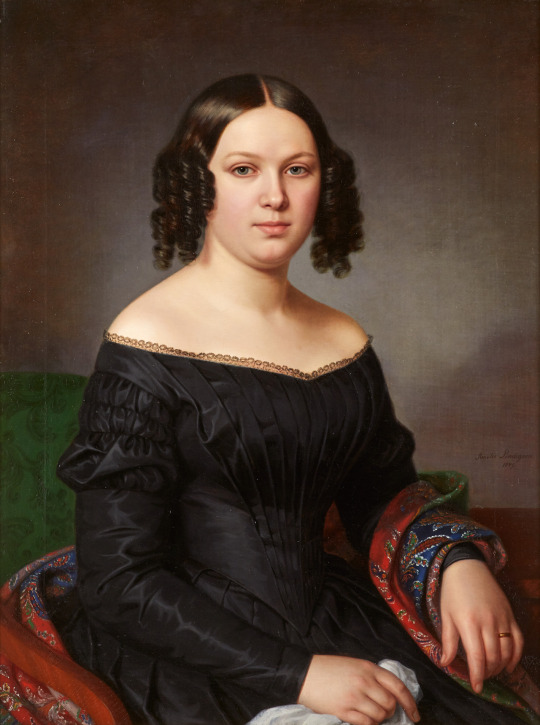


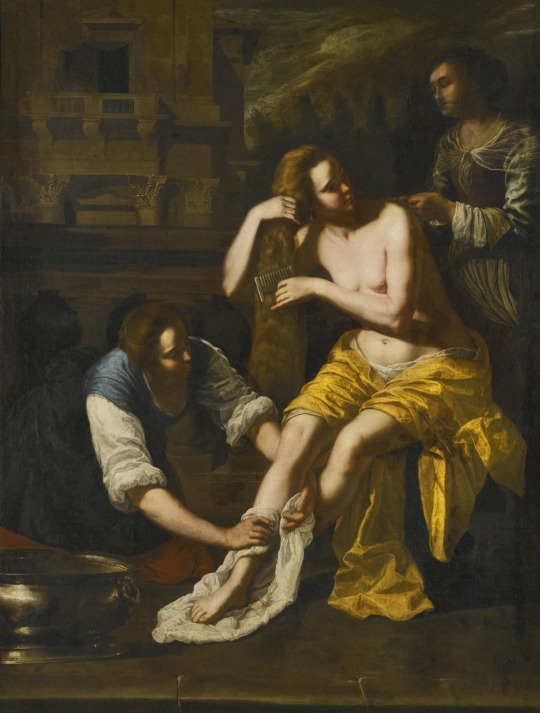
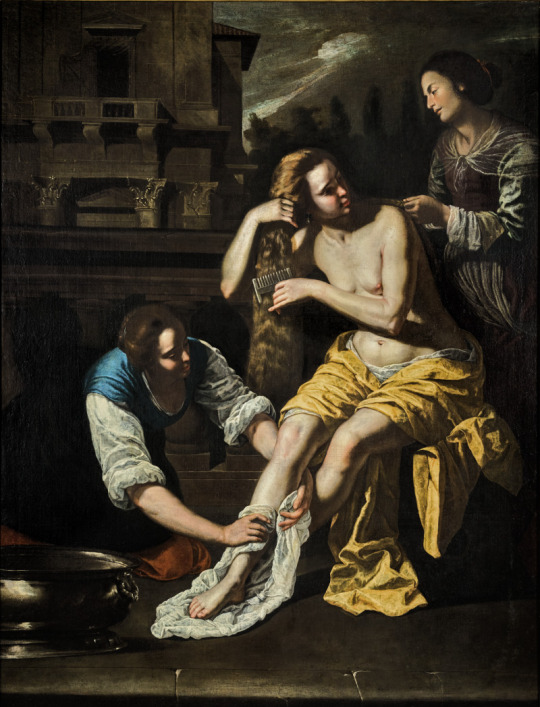
A short note on photography and reposts
Long-time followers may have noticed I occasionally repost the same pictures, sometimes months or years apart.
The way I work on this blog is simple: I try and find good paintings by women that are in the public domain*, then I upload then here, always with a link back to the source. I occasionally crop the images (when frames are shown in the original pictures for instance) but I never alter them in any other way. What this means is that the quality of the painting you get here is pretty much always the same as the original photography of said painting. Whenever a picture comes up for auction, it will be photographed again. Some pictures, inevitably, will be better than others, and that will occasionally warrant a repost from me.
Sometimes new information will come up as well. The first time I posted the portrait of the lady in black above, Uppsala Auktionskammare called it, quite simply, “Portrait of a young woman in black”. When it was up for auction again about ten months later in Stockholm, though, the sitter was identified as follows: “Portrait of baroness Catharina Eleonora Fredrika Märta Sparre (1832-1912), at the age of 21″.
And sometimes the same auctions houses will just take new pictures of artworks. “Bathsheba at her Bath” by Artemisia Gentileschi was sold at least twice by Sotheby’s, once in 2014 and once quite recently. I’ll let you be the judge of which picture is best.
Let this be a reminder to all of us never to assume we’ve “seen” a painting until we have actually been in the same room with it. We’re all looking at the invisible work of photographers here.
*As an aside, the law in the US as far as copyright goes, states that if a two-dimensional work of art is in the public domain, then a faithful photographic image of said work of art is also in the public domain.
Links to the original posts:
Amalia Lindegren (Swedish, 1814 - 1891): Portrait of a young woman in black (1849)
Amalia Lindegren (Swedish, 1814 - 1891): Portrait of baroness Catharina Eleonora Fredrika Märta Sparre (1832-1912), at the age of 21 (1849)
Anne Vallayer-Coster (French, 1744 - 1818): A bust of Minerva, armour, muskets, a drum, a standard, the baton of command of a Maréchal de Frace, a laurel wreath and the orders of Saint-Louis and of the Saint-Esprit, all on a stone ledge (1777)
Anne Vallayer-Coster (French, 1744 - 1818): A bust of Minerva, armour, muskets, a drum, a standard, the baton of command of a maréchal de France, a laurel wreath and the orders or Saint-Louis and of the Saint-Esprit, all on a stone ledge (1777)
Artemisia Gentileschi (Italian, 1593 – c. 1656): Bathseba at Her Bath
Artemisia Gentileschi (Italian, 1593 – c. 1656): Bathseba at Her Bath
123 notes
·
View notes
Text
History of Cufflinks: An illustrated timeline
Introduction
The cuff link has a long and interesting history intertwined with the development of ‘fitted’ clothing – which necessitated the use of buttons. Subsequent development of the ‘worked’ buttonhole, the Industrial Revolution and the evolution of mens’ fashion – culminating in the ‘French cuff’
youtube
Clothing in pre-historic times tended to be functional and related to the hunter-gatherer and later farming lifetyles. Leather, furs and fabrics tended to be wrapped around the body and tied. As these ancient societies evolved, the idea of ‘status’ along with status symbols developed. In terms of clothing fasteners in Ancient Ireland, the elaborate dress fasteners of the Bronze Age comes to mind.
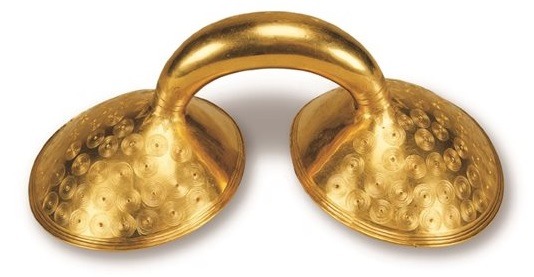
1200’s
Strings pins or belts were used rather than buttons to fasten clothing. It was not until fitted garments became popular in the 13th century that buttons where used as fasteners.

1600’s In the 17th century the decorative lacy cuff of the Renaissance began to give way to more practical styles. At first noblemen began using ribbons to tie their cuffs and the elegance of them was considered a status symbol. By the late 17th century ribbons were replaced by jeweled buttons which were called Sleeve Buttons.
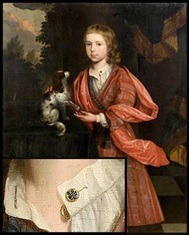
Sleeve Buttons were much more simple than lace They were also much more visually interesting than ribbons Sleeve Buttons became very popular very quickly in the 1600’s
1700’s
By the time of King George (1738-1820) these buttons had become much more ornate. one favourite style was to create miniature paintings on the underside of a piece of glass or quartz. It was still a bauble of the elite classes however, and they were quite expensive to produce due to the material costs involved. This like so many facets of European society changed rapidly with the coming Industrial Revolution.

1800’s
Cufflinks have often been accompanied by matching studs for the front of the shirt, particularly for formal wear from the 19th and 20th centuries.
At the beginning of the reign of Queen Victoria (1837-1901) and towards the end of Britain’s Industrial Revolution the middle class adopted cuff links.
Unable to afford gems they turned to replicas of the real thing. Rhinestones and pastes were used as fake diamonds Pinchbeck a copper and zinc alloy substituted for gold Cut steel marcasite were used for silver A ‘rose’ or flat cut was favoured by late Georgian and Victorian jewelers
1840
The French cuff or double cuff shirt sleeve become a popular fashion accessory. The historical stimulus for the elegant touch in mens’ fashion was the publication of Alexander Dumas “The Three Musketeers”
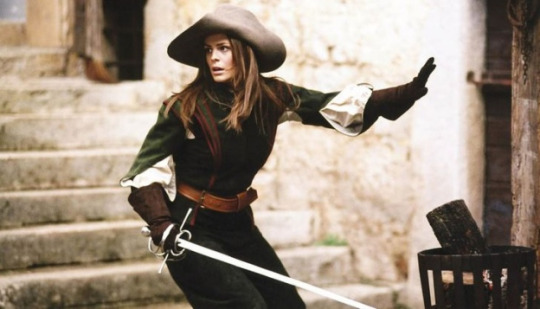
Dumas detailed description of the turned-back sleeves of the men guarding King Louis Xlll inspired European designers to modify the single cuff link-holed shirt which had been a fashion main stay in England.
1882 In 1882 George Krementz invented a machine that was based on a Civil War cartridge shell. It would mass produce one-piece buttons and cuff links very cheaply, which further enabled everyone to enjoy what was once the exclusive domain of the wealthy and privileged.
1900’s
Although the growing middle class liked enameled cuff links during the early Victorian period, it was during the Art Deco period that enamels reached their popularity. Skilled craftmen such as Faberge had perfected the art of using enamels by the end of the 19th century which he then mass produced during the early period of the 20th century.
The Faberage enamel cufflinks are said to have a gem-like brilliance and are highly sought after in auction houses throughout the world.

Other leading cuff link designers like Cartier and Tiffanys also began produce cuff links at the turn of the 20th century and were heavily influenced by the Art Nouveau – Art Deco, Cubism period.
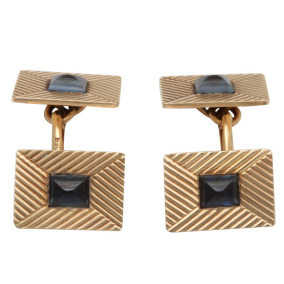
The Roaring 20s were probably the height of cuff-link invention. Manufacturers created a variety of devices and designs to do one simple thing: permit a fellow to insert and remove his cufflinks with a minimum of difficulty and a maximum of security.
1924
In 1924, a Mr Boyer, of the Boyer company, created a fastener system made up of a tilting stick between a double stem fixed to the base. Nowadays, this system still remains the most common fastener used.
1950’s
The “stirrup” link enjoyed some popularity in the 1950’s – a curved bar encompassing the cuff from one side to the other.
1970’s In the Seventies, shirts with built-in buttons replace cuff links. Fortunately, the haute couture of famous names kept the style of wearing cuff links which continued to influence many people and kept the tradition alive.
1987 In London salerooms, no provenance is more sought-after than a royal connection. Britain’s royal family rarely parts with jewellery but Edward VIII was one who flew the coop, abdicating in December 1936, to marry the American divorcee Wallis Simpson. She became the Duchess of Windsor and her jewellery was sold at a landmark auction in Geneva in 1987 which raised $50 million. However pieces from the couple’s collection still turn up.
One pair of cuff links sold at auction for $440,000.
They were engraved with the initials ‘E’ and ‘W’
1990’s
The French cuff shirt make a dramatic come back and cuff links become a main stream fashion accessory spanning across all ages. Young people rediscover this accessory.
Paul Smith & Gucci brands start to expand and increase their new cuff link ranges.
A new generation of cuff links was born.
Cuff links, once viewed as a formal jewel becomes an essential accessory for both men and women wanting to express their individuality with style.
2000’s
Today cuff links are worn all over the world by men and women of discriminating taste and style. Whether it’s a classic or a modern design – or even one of the latest in novelty designs – cuff links are something that can be worn and appreciated by anyone who wants to look their best.
2010’s
In 2014, Sotheby’s in London sold a selection of the couple’s jewels and precious objects including a pair of gold and painted enamel cufflinks, featuring portraits of the Duke’s grandparents King Edward VII and Queen Alexandra
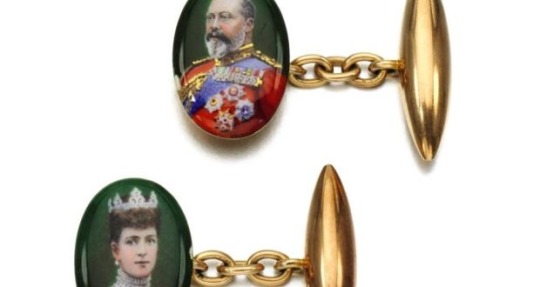
It is often said that a man should never buy his own cufflinks, but that they should always be gifts meant to mark an occasion.
This is a custom that resonates back to the cufflink’s medieval history, to the time when they were made almost exclusively as items meant to commemorate royal affairs.
Thus, these days men have come to recognize the importance of the set passed-down from a grandfather, or given by a best friend at his wedding and might solely rely on such pieces for formal affairs, but are uninhibited about buying their own cufflinks for everyday wear.
View Source: https://numiscufflinks.wordpress.com/2016/03/31/history-of-cufflinks-an-illustrated-timeline/
3 notes
·
View notes
Photo

Howard Charles as Porthos in ‘The Musketeers’ (TV Series, 2014-2016).
( Source: FARFARAWAYSITE )
#howard charles#porthos#the musketeers#perioddramaedit#fashion#brown hair#brown eyes#17th century#Phoebe de Gaye
212 notes
·
View notes
Photo
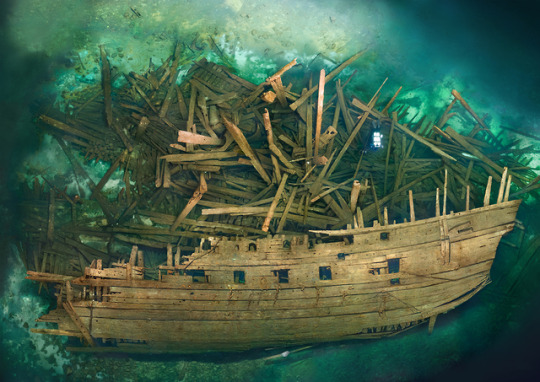
Wreck of the swedish Mars 1564
May I introduce ? this is the flagship of the Swedish Navy under King Erik XIV, the Mars Makalös (the flawless, sometimes also called the Jutehattars, Danish hater) from 1563.
It was part of a major armament campaign initiated by Erik to gain the final upper hand in the Baltic Sea and to force the countries, northern Germany, Denmark and the rest of Western Europe in their places.
Ship type, rigging and crew
She was built between 1561 and 1563 in Birkenes. Her master builder was Holger Ohlsson, a master shipbuilder from Stockholm. What kind of ship she exactly is not yet aware of, it seems to be suspected to be a mixture of Carrack and Caravel. Possibly it is an early galleon, a ship-of-the-line. She was 50 m long, about 13-15 wide and weighed about 1,800 tons. A ship of Mars size during this time may well have had four masts. On a copper plate showing the Mar´s downfall the ship has four masts. Possibly the Mars was one of the first vessels in Sweden who were fitted with a third sail, the “upper topsail” .
This is different from the few years older Elephant which only had two sails on the same mast. Mars may have had five or seven crow´s nest. The crew of Mars amounted to about 670 persons, of whom about 350 were boatmen and the other for the most part soldiers. Most of the sailors and soldiers were enlisted. On board the ship was also the admiral, the old trustworthy Jacob Bagge.
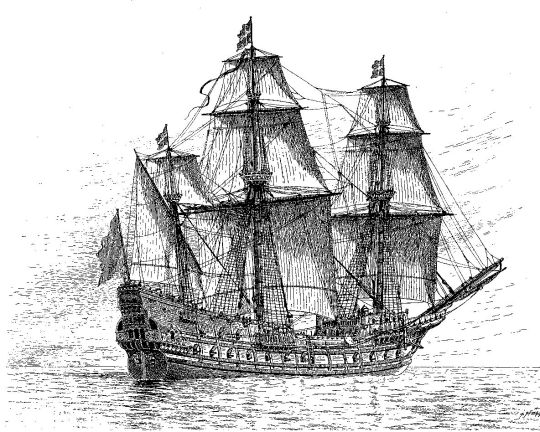
A drawing of the Mars by Jacob Hägg, 1909
Armament
Armament could vary significantly from year to year, depending on availability and needs. Cannons were called simply called “shooter” and the different types went under a series of names, such kartoger , slangor (snakes) and falconets. Of these there were also classes, three forth kartoger, half kartoger and so on.
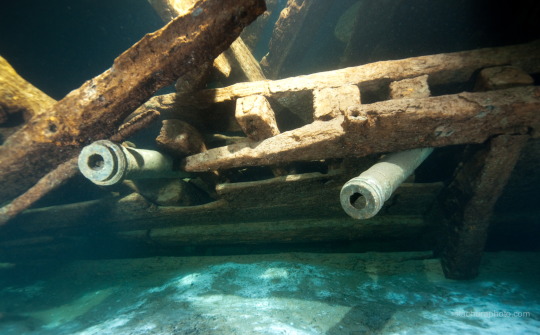
On Mars’ starboard side, the hull lists towards the seabed. Cannons still point out through their portholes.
Mars was almost exclusively armed with muzzle-loading bronze cannons, but they also had rapid-fire, but less powerful breechloader iron guns on board. There are various data on the number of guns in Mars, one source tells 173 and another 107 pieces, including:
2 pieces of 48-pounder 2 pieces of 36-pounder 9 pieces of 24-pounder 10 pieces of 12-pounder 4 pieces of 9-pounder 20 pieces of 6-pounder 6 pieces of 3-pounder 4 pieces of stone boxes 50 Falkoner / falconets (light cannon)
The guns where cast in Stockholm, but also in Kalmar. Cannon carriages are manufactured at Norrmalm, Stockholm and Kalmar. On the English ship Mary Rose 1545, the big bronze cannons had “four roll boxes”, ie, carriages with four wheels. Iron / chamber guns were in carriages with two wheels. On board the Mars, there were 53 “boxes” (carriages) of unknown type. The building accounts of the ship Elephant from the same period mentioned installation of the “byssebänkar” (shooting benches) which may have meant guns without wheeled carriages.

Cannon still sits in its carriage. To the right are rolls of lead, stacked. The lead was used for hull repairs but also for casting ammunition for muskets and small caliber cannons.
Ammunition
There were a variety of ammunition types on board in addition to round balls. Chain shots where used to destroy the rig. The latter could also be used against the crew which also could face heavy hail from so-called scrap shots or canister shots. They also used the “fireworks”, incendiary grenades, and fire-balls (container filled with flammable material).

Cannon ball made of stone most likely used in back-loaded iron cannons
Small arms
To fight the enemy before boarding, in addition to shooting scrap shots they made use of crossbows, bows, hook guns and muskets. For close combat axes and short spikes where the weapon of choice. There were different types of gunpowder, a faster burning “krönekrut” for muskets and a slower burning gunpowder for the cannons.
Nordic Seven Years’ War
Not much is known about Mars over the period immediately after its completion, and it has only had a short period of service. Its most important historical event was a battle in the Baltic Sea during the Three-Crown War, also known as the Nordic Seven Years’ War. During this conflict, the Kingdom of Denmark stood on one side, forming an alliance with the Hanseatic city of Lübeck and the Kingdom of Poland, and the Kingdom of Sweden on the other.
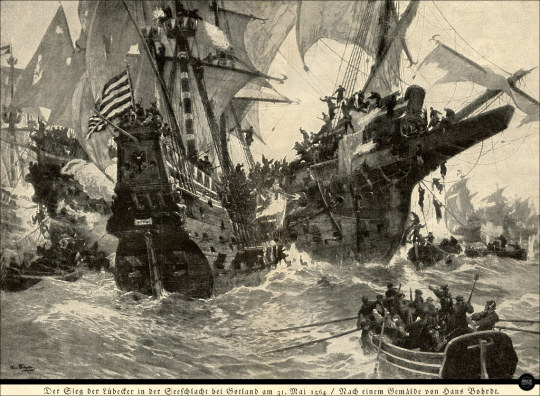
Sieg der Lübecker über die Schweden in der Seeschlacht bei Gotland am 31. Mai 1564/ Victory of the Lübeckers over the Swedes in the naval battle near Gotland on 31 May 1564 by Hans Bordt 1901 a wall painting on the wall of the red room , Lübecker city hall
On 30 May 1564, a two-day battle between the two conflicting parties took place in the Baltic Sea between the islands of Öland and Gotland. 16 Danish large ships led by Admiral Herluf Trolle and 10 Lübeck large ships led by Admiral Friedrich Knebel faced 16 Swedish large ships commanded by Admiral Jakob Bagge. On the first day the Swedish ships could inflict damage on their opponents after short but fierce battles. With nightfall the battle was interrupted and only continued the next day. When the wind changed on the second day, the Swedish ships had to retreat one after the other because of the unfavourable winds for them - only Mars continued fighting alone and was surrounded by the Allied supremacy. Mars nevertheless succeeded in sinking a Lübeck ship and damaging several Danish ships. The Lübeck Chronicle reports that the numerically superior allies succeeded in disabling Mars’ rudder by gunfire. However, it was found undamaged on the seabed.
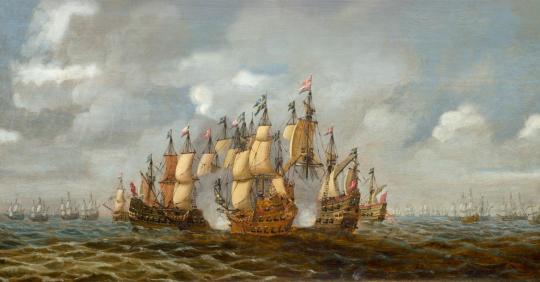
Battle of Öland 30 May 1564 by unknown artist
In the course of the following exchange of blows, the crew of Lübeck’s flagship Der Engel/ The Angel, led by Admiral Friedrich Knebel, applied Mars together with the ships Byens Løffue (Denmark) and the Lübeck Fuchs / Fox. In a very hard battle the crews succeeded in approaching Mars in such a way that it could be boarded. During the boarding the Swedish ship caught fire, which spread quickly. The Lübecker managed to capture the commander-in-chief of the Swedish fleet, Admiral Jakob Bagge, and his second-in-command Arvid Trolle. Finally, Mars exploded a short time later, when the Lübecker plundered the ship’s magazine. 880 Swedes, Danes and Lübeckers were on the ship at that time. A large part of it drowned or became victim of the flames and/or the explosion pressure wave or flying explosion debris. Friedrich Knebel later reported to his superiors that “500 were killed, 100 were captured”. Jacob Bagge was imprisoned in Copenhagen and was released several years after the war. Mars finally sank to a depth of 75 m on 31 May 1564.
Finding the wreck
On 19 August 2011 it became known that the wreck of Mars was found by a team of divers at a depth of 75 metres, about 18.5 kilometres north of Öland. The archaeologists hope to find well-preserved artefacts and many new findings about the ship. The cold, low-oxygen water of the Baltic Sea offers ideal conditions for the conservation of the 400-year-old ship - especially as the wood-decomposing shipworm does not occur here either.
The Mars is very intact, in fact all of the wood is still there. Cut marks from carpenters axes can still be seen and traces of white paint. The explosion and the test of time have caused her to partly collapse. The port hull side remains almost completely intact with rows of cannon ports. The wreckage sticks up some 11m from the bottom at its highest point. In the stern divers can swim into the wreck in an area that may have been the admiral’s quarters.
The starboard side of the ship has collapsed outwards revealing her insides. Cannons too many to count litter the wreck site along with numerous other objects.The wreck site is large, there are object as far as 150m from the wreck. Probably thrown there by the explosion. The historical accounts tell of the main mast shooting up like an arrow. To the east of the wreck site there is mast like remains. They have not yet been investigated. To date less than a handful dives have been done on the Mars. Much remains to be discovered. The Mars is sure to hold many surprises in the future.
youtube
A small video to see her and a bit of her history made by National Geographic
(Sources: National Geographic 2017, X-RAY Magazine No.59 2014 and MARIS research institute at Södertörn University, Deep Sea Production, Marin Mätteknik, Swedish National Defence College, The Maritime Museum, The Vasa Museum, Center for Maritime Studies at Southampton University, Kalmar County Museum)
401 notes
·
View notes
Photo
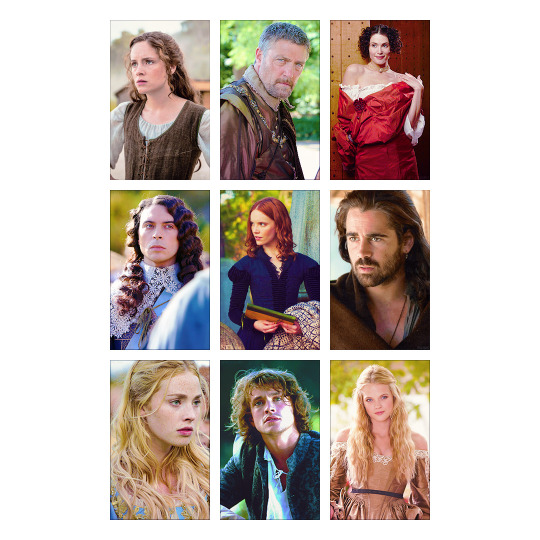
BAROQUE AVATARS PACK
By clicking the source link, you’ll find 276 avatars for roleplay, made by myself from various baroque sources.
jamestown (2017-2019), nell gwynn (2016), new worlds (2014), salem (2014-2017), the musketeers (2014-2016), the new world (2005), the three musketeers (211), young blades (2001)
Please check the rules!
#avatars pack#rp avatars#period fc#baroque era#rpg resource#avatars#avatars 400*640#roleplay#forum rpg#baroque#*avatars#*mine
10 notes
·
View notes
Note
Where do you find most of your pictures for your soiaf graphics
I posted a few days ago about sources for more general picspams, which also applies to my ASOIAF picspams. But I'd also include:
Tumblrsartoficeandfire - my own blog, yes, but I do use it a lot. fuckyeahcostumedramasicapturetheperiodpiecesmedieval-dressessomanyperioddramas
I mentioned Wikimedia Commons before, but here are the most useful categories:https://commons.wikimedia.org/wiki/Category:Chronological_series_of_Kings_of_Spain_(commissioned_by_Isabella_II)https://commons.wikimedia.org/wiki/Category:Lithographs_of_the_rulers_of_France_from_Pharamond,_King_of_the_Franks_to_Napoleon_(Delpech)https://commons.wikimedia.org/wiki/Category:Medieval_miniatures_of_queenshttps://commons.wikimedia.org/wiki/Category:Middle_Ages_in_arthttps://commons.wikimedia.org/wiki/Category:Portraits_of_the_Counts_of_Barcelona_(series_by_Filippo_Ariosto)https://commons.wikimedia.org/wiki/Category:Portraits_of_kings_of_Arag%C3%B3n_by_Manuel_Aguirre_(Diputaci%C3%B3n_Provincial_de_Zaragoza)https://commons.wikimedia.org/wiki/Category:Portraits_of_Kings_of_France_(series_commissioned_by_Louis_Philippe_I_-_Versailles)https://commons.wikimedia.org/wiki/Category:Portraits_of_the_real_and_legendary_Kings_of_Scotland_(series_by_James_de_Witt_-_Holyrood_Palace)https://commons.wikimedia.org/wiki/Category:Queens_in_art
Movies and Television shows I've used:
Alexander
Arn – The Kingdom at Road's End and Arn – The Knight Templar
Beowulf & Grendel
Black Death
Los Borgia
Borgia: Faith and Fear
The Borgias
Braveheart
Brotherhood of the Wolf
Camelot
Carlos, rey emperador
Cinderella (2015)
Clash of the Titans and Wrath of the Titans
The Chronicles of Narnia: The Lion, the Witch and the Wardrobe, Prince Caspian, and The Voyage of the Dawn Treader
Da Vinci's Demons
The Devil's Whore
Dracula Untold
Earthsea
The Empress of China
Eragon
Ever After
Excalibur
First Knight
Gladiator
Hamlet (1990)
The Hollow Crown
Immortals
In the Name of the King: A Dungeon Siege Tale
Ironclad
Isabel
Ivanhoe (1982, 1995, and 1997)
Joan of Arc (1999)
King Arthur (2004)
Kingdom of Heaven
A Knight's Tale
Knightfall
Labyrinth (miniseries)
The Last Kingdom
Legend
The Legend of the Sword
The Lion in Winter (1968 and 2003)
The Lord of the Rings and Hobbit movies
Maleficent
Marco Polo (TV series)
Medici: Masters of Florence
Merlin (1998 and 2008 TV shows)
The Messenger: The Story of Joan of Arc
The Mists of Avalon
Muhteşem Yüzyı and Muhteşem Yüzyıl: Kösem
The New World
Once Upon a Time
The Pagan Queen
The Pillars of the Earth
Pirates of the Caribbean: On Stranger Tides
Reign
Robin Hood (1991, 2010, and 2018 films & 2006 TV show)
Romeo and Juliet (1968 and 2013)
Rome
Salem
Spartacus: Blood and Sand, Gods of the Arena, Vengeance, and War of the Damned
Stardust
Still Star-Crossed
Sword of Vengeance
The Three Musketeers (2011 film and 2014-2016 TV show)
Troy
The Tudors
The Vampire Diaries (the flashbacks to the 15th century, specifically)
Vikings
The Virgin Queen
Vision – From the Life of Hildegard von Bingen
The White Princess
The White Queen
Wolf Hall
World Without End
Your Highness
A lot of these are ... not great, but they have pretty visuals.
7 notes
·
View notes